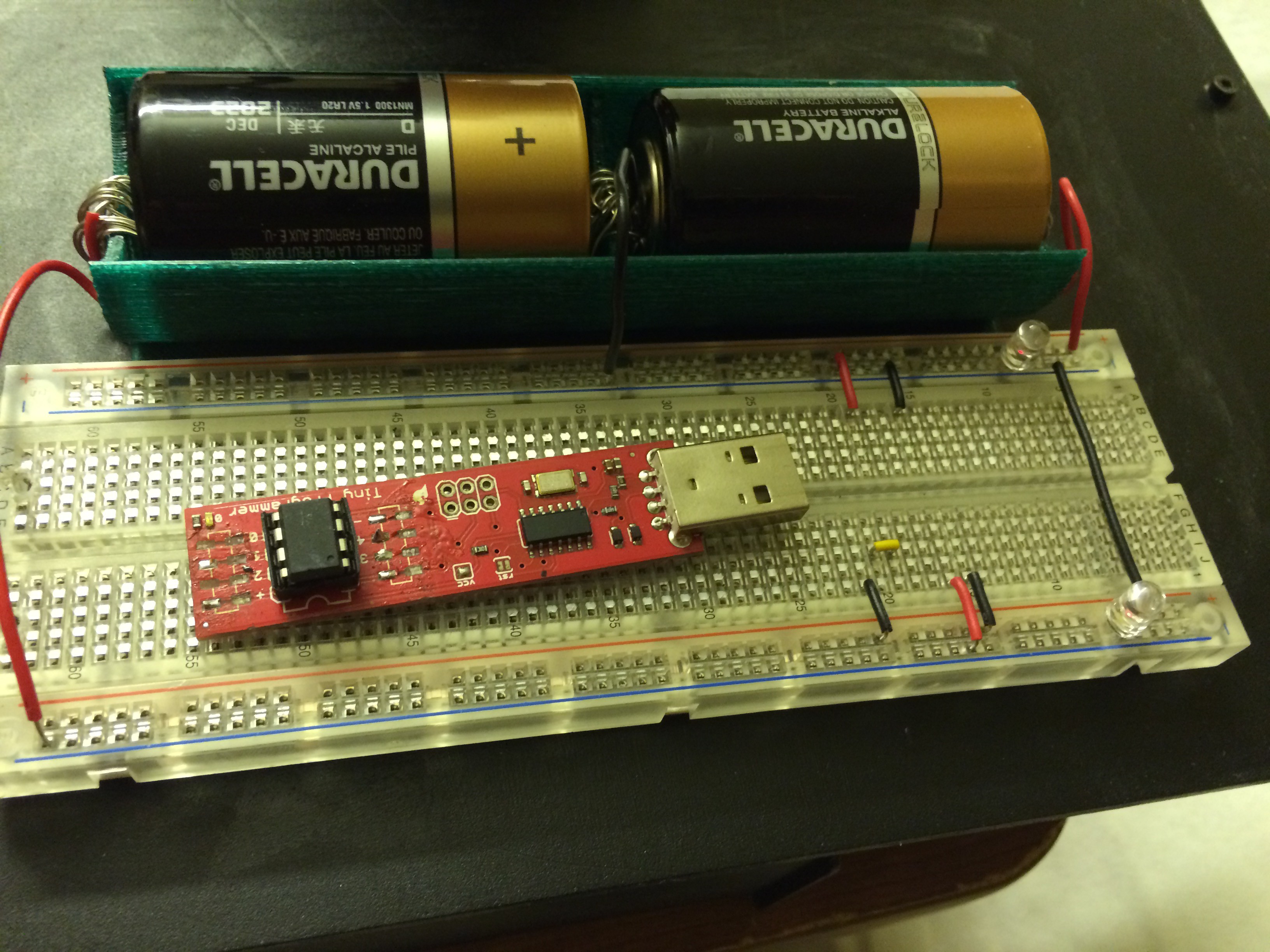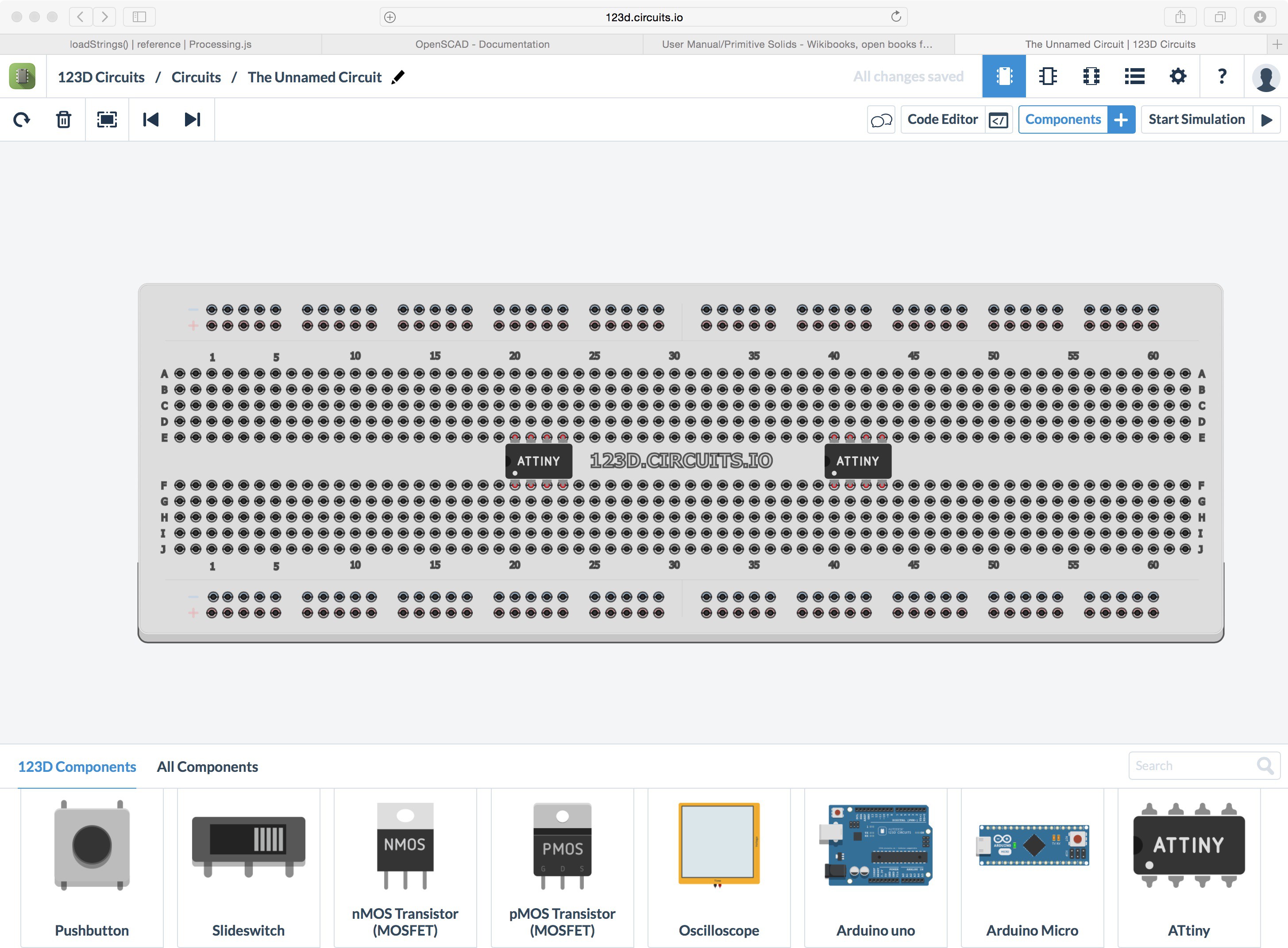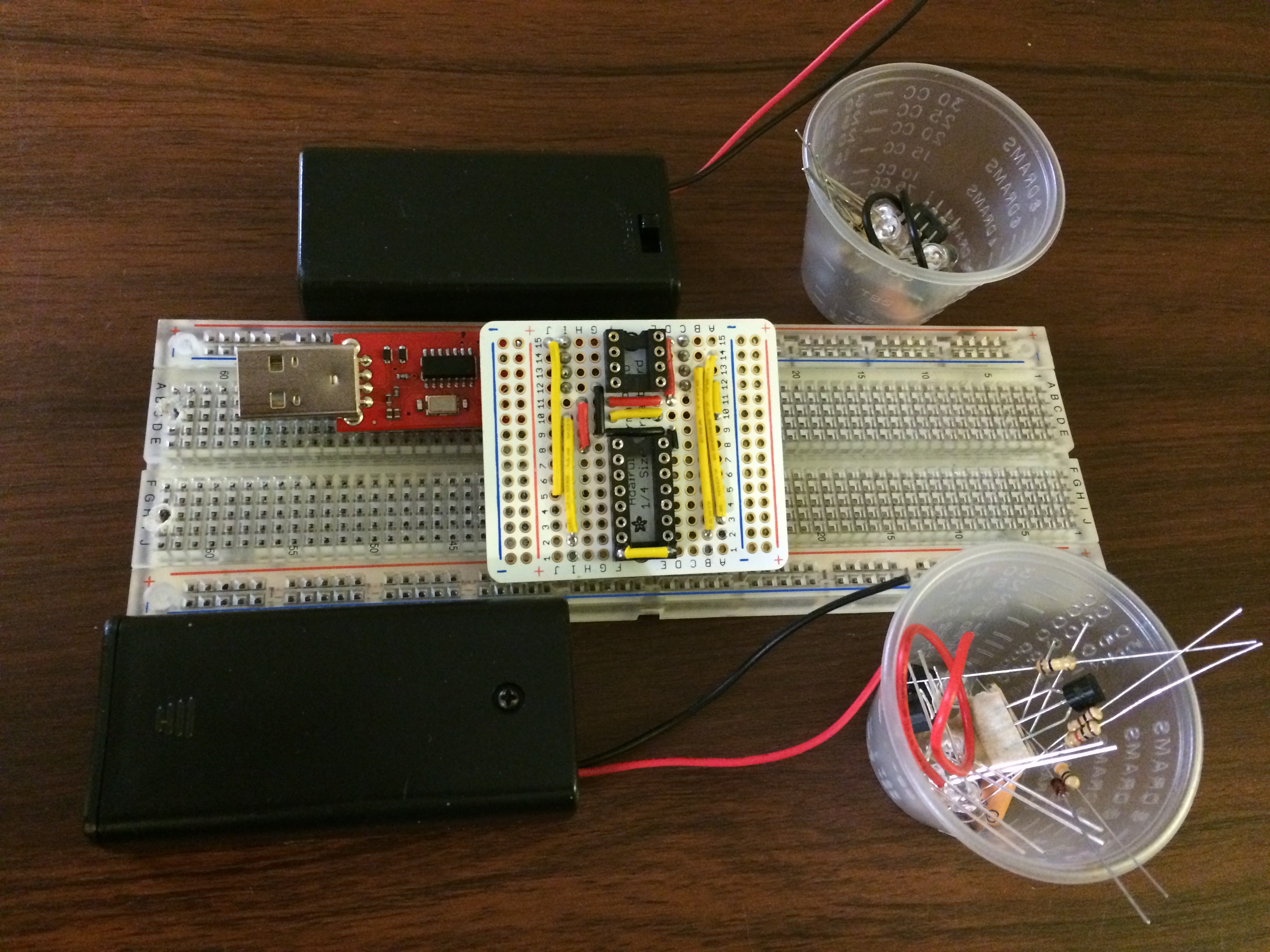-
Battery Pack and Programmer Woes
03/31/2015 at 05:43 • 0 commentsAbove you can see the new battery pack that I 3d printed and the programmer with the broken traces because the adapter board I soldered to it broke off. I think I can fix the programmer with some careful soldering since a header was provided mid-board. Once that is done I'll be ready to perform a test run game of Circuit Wars!
-
123D.Circuits.io
03/22/2015 at 22:37 • 0 comments![]()
What amazing news! I do some web searching for a simulator and I discover 123D.Dircuits.io! It is a simulator that seems to be all but specifically designed for the purposes of playing Circuit Wars! It appears to allow the placement of multiple processors, the simulation of their code, and analog circuit design as well. About the only missing from this picture is a two-person interface and that can be solved by referee or by remote control of the web interface.
If you trust the other player you can use TeamView and if not you can use a neutral computer. This is a very exciting development for the game! more to follow!
-
Audible Zaps and More
03/21/2015 at 18:26 • 0 commentsSo we have established that Circuit Wars can be played remotely or by simulator and if we add inductors and transistors, chip-destroying high voltage spikes can become part of the game. What would be even more cool would be if we used speakers as inductors, causing their destruction to be audible if within hearing range. Also the process of tuning a circuit for highest output voltage to further create destruction would be more audible if the capacitors in the kit had values selected for resonance or switching in the audio range.
Similarly, LEDs may be used as diodes to shunt such attacks, causing bright flashes of light as they fail or intense light as they succeed. Beyond the use of inductors, transistors add another level of attack technique by boosting the charge delivered to the opponent's chi(s). Transistors can be part of circuits that invert or boost voltage as well.
So it seems that a properly selected set of components is critical to the fun of Circuit Wars!
-
Move by Move
03/21/2015 at 15:57 • 0 commentsI got to talking with Don S. of the 10BitWorks Hackerspace and he asked me if this could be a nationwide thing. I thought a moment and recalled the old game of Battleship. A9 A8 A7 "You sank my battleship!" Well, a breadboard has a letter-number designation for each of the holes and the parts have designations for each of the pins (when it matters), so it would be fairly straightforward to develop a game notation much like a chess game notation but a bit like battleship also for Circuit Wars.
This means that the game can be played remotely or even virtually by simulation. A hybrid digital/analog simulator with a set of processor models could simulate much of what is happening on a real hardware implementation. This opens up another category of competition, the simulation game, and it also opens up the possibility of playing the game when opponents are located remotely.
So now there is no need for travel to compete at the international level - this makes the likelihood that the game will be widely used much more practical. Also, as far as sponsors the electronics suppliers are already sponsors of Maker events, so I know where to look for sponsorships. tres cool!
Les
-
Battle Rules and Procedures
03/21/2015 at 13:01 • 0 commentsOK, i have a set of rules to work with now. This is tentative but I think its a good starting point.
Each competitor (may be a team) is given 15 minutes on a chess clock (may be a phone app or a tangible chess clock) to place their components on the breadboard. Components may be placed anywhere on the battle breadboard.
Pins may not be shorted to power or ground except for power and ground themselves, which need not be directly connected if so desired. In nondestructive battles, transistors and inductors are left out of the kits, while in destructive competition, transistors and inductors are allowed.
When inserting a component, all of it's leads must be inserted for the move to be considered complete. If the referee observes an incomplete or ill-timed move, there is a one minute penalty. for this foul. Opponents may wish to intentionally foul to burn time if this is deemed advantageous.
Competitors may switch on power in any move after the move in which the power supply leads are connected. Once a component is placed, none of its leads may be relocated or removed, lest a one minute penalty occur.
Chip programming may be altered at any time during the placement session and preprogrammed code is permitted.
Once time runs out or both competitors declare they are GO for Battle, a 5 minute timer run by the referee's signal begins counting and the competitors may switch on their power supply switches at any time during that 5 minute interval.
Once the 5 minute time is expired, the referee declares a winner by determining the activity level of each chip using a chip clip and measuring the bandwidth of the chip's pins. Chips with zero activity level may not advance to the next round. In the event that both chips are active and both share the exact same activity level to within the tolerance of the measuring equipment, both competitors then advance to the next round. This is declared a "double win".
May the best team reign victorious!
-
First Step: A Nondestructive Battleground
03/21/2015 at 09:42 • 0 commentswell I don't have any inductors but I do have some magnet wire, R's C's, Q's and various chips for creating a battleground. It seems however to make sense to define some standard circuit for the initial competitions. The chips, however, cost $2+ each in small quantity and I only have so many of them, so why not design something safe? How about a battle to activate the other processor's RESET function? This can be a practice category for learning and testing that is chip-safe. Hard core high voltage duels with shorts and spikes can wait until later.
I could make a secret logic function using a referee chip in the middle of the two combatants. The referee listens to the signals from the five i/o pins of the warrior chips and does it's hocus pocus, perhaps from a pseudorandom key based on a human time interval in pressing a button, to decide when to apply reset to the adjacent processor. Something like that...
Circuit Wars
Kill the other Chip! In this Chess-like game of electronics skill, you must disable or destroy the opponent's microcontroller chip.
 Les Hall
Les Hall

